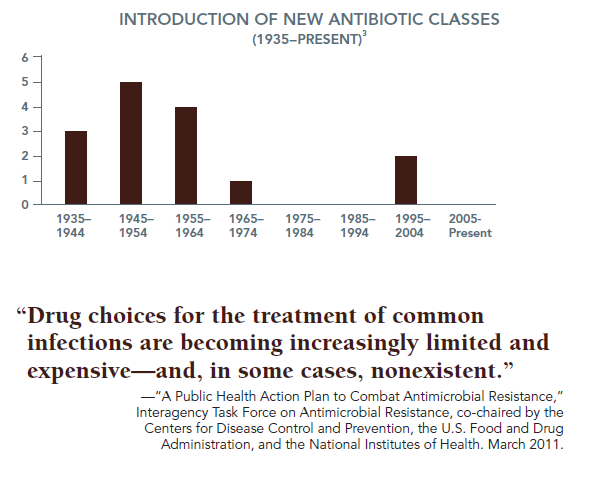The Superbug Threat
As drug-resistant bacteria spread, the pipeline for antibiotics is drying up
Humankind is in an arms race with drug-resistant superbugs—and bacteria have the upper hand.
Although drug makers developed 13 new classes of antibiotics between 1935 and 1968, only two new classes of these medications have emerged in the more than four decades since then.1 This leaves doctors with fewer options to fight a rising tide of drug-resistant infections.
If this trend continues, warns Dr. Thomas Frieden, director of the Centers for Disease Control and Prevention, we could enter “a post-antibiotic era.”2

Challenges to Antibiotic Innovation
Whereas scientific, economic, and regulatory forces have worked in relative harmony to produce many safe and effective medical treatments, they conspire to slow the development of new antibiotics.
SCIENTIFIC CHALLENGES
Antibiotics are difficult to discover.4
- The bacteria that present the greatest danger today have sophisticated defense mechanisms that make them difficult to kill with antibiotics—including multiple cell walls, “pumps” to expel some antibiotic molecules, and chemicals that inactivate others.
- In addition, new drugs must overcome all of these hurdles without poisoning the patient taking them.
ECONOMIC CHALLENGES
Antibiotics tend to produce lower revenues than many other types of drugs.5
- Antibiotics are used sparingly to slow the rate of resistance.
- These drugs are often taken for short periods of time (rather than daily for a lifetime like treatments for conditions such as diabetes and hypertension).
- They tend to be priced lower than other drugs.6
REGULATORY CHALLENGES
Compared with other drug types, it is more difficult to test antibiotics and secure approval for them from the U.S. Food and Drug Administration.7
- Test subjects for drug trials are hard to find; often, there is a lack of diagnostic tools to identify the particular bacteria causing patients' infections.
- The drug approval process for new antibiotics is in flux and needs greater predictability.
References
1. J. H. Powers, “Antimicrobial Drug Development—the Past, the Present, and the Future,” Clin Microbiol Infect 10 Suppl 4 (2004): 23–31.
2 T. Frieden, “Antibiotic Resistance and the Threat to Public Health,” testimony before the House Committee on Energy and Commerce, Subcommittee on Health, released April 28, 2010.
3 Based on data from: J.H. Powers, “Antimicrobial Drug Development—the Past, the Present, and the Future,” Clin Microbiol Infect 10 Suppl 4 (2004); 23–31.
4 “Innovative Mechanisms for Tackling Antibacterial Resistance,” The Royal Society, last modified July 26, 2008, royalsociety.org/uploadedFiles/Royal_Society_Content/policy/publications/2008/7932.pdf.
5 E. Power, “Impact of Antibiotic Restrictions: The Pharmaceutical Perspective.” Clin Microbiol Infect 12 Suppl 5 (2006): 25–34.
6 T. Parker-Pope, “Free Antibiotics May Contribute to Drug Resistance, Officials Say,” New York Times, March 4, 2009,
www.nytimes.com/2009/03/05/health/policy/05drugs.html
7 D. M. Shlaes, Antibiotics: The Perfect Storm. New York: Springer Science+Business Media, 2010.






